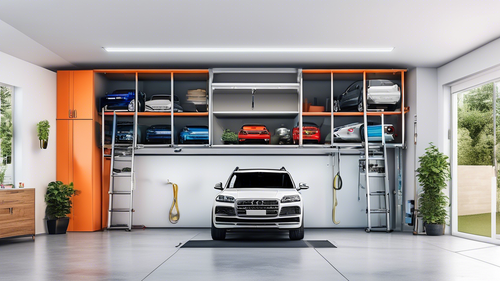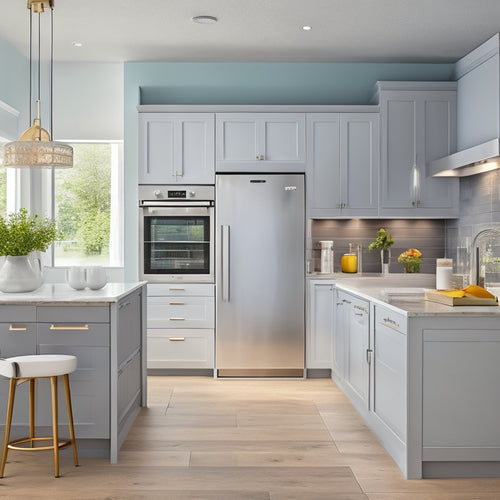
Organize Your Entryway With a Simple Mudroom System
Share
You can reshape your cluttered entryway into a haven of organization and calm by implementing a simple mudroom system. Start by observing your daily routines and habits to identify necessary storage for shoes, bags, and keys, and optimize traffic flow to reduce congestion. Choose durable, easy-to-clean materials that reflect your desired aesthetic, and plan a layout that includes a bench or console table, calming color schemes, and adequate lighting. By building a sturdy frame, adding shelves and hooks, and incorporating functional accessories, you can create a personalized space that streamlines your daily routine - and by digging deeper, you'll uncover even more ways to customize this space to fit your needs.
Key Takeaways
- Assess daily routines and habits to identify necessary storage for shoes, bags, and keys, and optimize traffic flow to reduce congestion.
- Choose durable, easy-to-clean materials that fit your budget and desired aesthetic, considering factors like scratch resistance and weather tolerance.
- Plan a functional layout with a bench or console table, calming color scheme, and adequate lighting to create a serene atmosphere.
- Build a sturdy frame and shelving system to maximize storage, with adjustable hooks and accessories to enhance functionality and style.
- Add personal touches like family photos and decorative elements to create a welcoming atmosphere, and maintain organization with a "one in, one out" policy.
Assessing Your Entryway Needs
As you stand in your entryway, take a moment to observe how you and your family members use this space.
Take note of the daily routines, habits, and clutter that accumulate here. Consider the entryway functionality you need to make your life easier. Do you need a spot for shoes, bags, or keys? How about a place to hang coats or store gloves?
Think about the flow of traffic and how you can optimize the space to reduce congestion. To prevent clutter from building up, consider adopting a one in, one out policy and regularly revisit your organized space to maintain momentum.
By maintaining a clutter-free entryway, you'll be able to focus on more important things in your daily routine. Ask yourself what you want to achieve with your entryway organization.
Choosing the Right Materials
You'll want to choose materials that can withstand the wear and tear of daily use, so consider durability factors like scratch resistance, moisture tolerance, and weight capacity.
Your budget will also play a significant role in your material selection, so it's crucial to find options that meet your needs without breaking the bank.
Material Durability Factors
When designing your entryway, selecting the right materials is vital to creating a functional and stylish space that can withstand the wear and tear of daily use.
You'll want to reflect on materials that offer weather resistance, as they'll be more likely to hold up against moisture, humidity, and extreme temperatures.
Maintenance requirements are also important - choose materials that are easy to clean, resistant to scratches and dents, and can withstand heavy foot traffic.
Additionally, think about the overall aesthetic you want to achieve and select materials that fit your style, whether it's modern, traditional, or rustic.
Budget-Friendly Option Selection
Three essential factors to take into account when choosing budget-friendly materials for your entryway are cost, functionality, and aesthetics.
You'll want to balance affordability with durability and style. Consider repurposing thrift store finds, like an old bench or vintage hooks, to add character to your space.
DIY upgrades, such as refinishing or repainting, can also breathe new life into second-hand items. Additionally, look for affordable alternatives to expensive materials, like using MDF instead of solid wood.
Designing Your Mudroom Space
As you step into your home, a well-designed mudroom space can make all the difference in creating a sense of calm and organization. It's crucial to visualize how you want your mudroom to function and look. Consider your mudroom layouts and entryway aesthetics.
| Design Element | Considerations |
|---|---|
| Layout | Will you have a bench for sitting or a console table for keys? |
| Color Scheme | Choose calming colors to create a sense of serenity. |
| Lighting | Will you use overhead lighting or table lamps for a cozier feel? |
| Textiles | Select durable, easy-to-clean materials for your mudroom furniture. |
| Decor | Add personal touches, like family photos or artwork, to make the space feel welcoming. |
Building the Storage System
You'll start building your storage system by constructing a sturdy frame that can support the weight of your essentials.
Next, you'll add shelves to store items like baskets, bins, and out-of-season gear.
Building the Frame
How much clutter can one entryway hold before it becomes overwhelming? It's time to take control and build a simple mudroom system.
Building the frame is the first step. You'll need to determine the frame dimensions based on the space available in your entryway. Consider the width, height, and depth you need to fit your storage needs.
For a standard frame, aim for a width of 36-48 inches, a height of 60-72 inches, and a depth of 12-18 inches. Use 2x4 lumber for the frame construction, and assemble it using screws or nails.
Make sure the frame is level and secure before moving on to the next step. A sturdy frame is essential for a functional and organized mudroom system.
Adding Shelves
Three to five shelves should be sufficient for most entryways, providing ample storage for your family's belongings.
When deciding on shelf placement, consider the items you'll be storing and how often you'll need to access them. Install lower shelves for heavier or bulkier items, like backpacks or shoes, and reserve upper shelves for lighter or less frequently used items, like hats or gloves.
Add decorative accents, such as trim or molding, to give your shelves a finished look. Make sure to leave enough space between shelves for easy retrieval and to prevent overcrowding.
Installing Hooks
Installing hooks is a great way to maximize your entryway's storage potential, picking up where your shelves leave off.
You'll want to contemplate strategic hook placement to guarantee everything has a designated spot.
-
Choose the right hooks: Opt for heavy duty hooks for bulky items like backpacks and coats, and decorative hooks for a stylish touch.
-
Reflect on adjustable height hooks to accommodate different family members or seasonal items.
-
Coordinate with your color scheme to create a cohesive look.
- If you have little ones, look into child-friendly options, like soft-grip hooks or alternative solutions like bins and baskets.
Adding Hooks and Accessories
Your entryway's functionality gets a significant enhancement with the strategic addition of hooks and accessories.
You'll be amazed at how these simple elements can streamline your daily routine. Start by selecting functional accessories that cater to your specific needs, such as a mail organizer, key holder, or a tray for small items.
Next, install decorative hooks that add a touch of style while providing a convenient spot to hang coats, hats, or bags. Consider a mix of single and double hooks to accommodate varying item sizes.
Final Touches and Styling
Now that you've optimized your entryway's functionality, it's time to focus on the finishing touches that will make this space truly shine.
It's all about adding those personal touches that reflect your style and make your mudroom feel welcoming.
Here's how to do it:
-
Choose a cohesive color scheme to tie together your decorative accents and functional textiles.
-
Add seasonal decor to keep your space feeling fresh and updated throughout the year.
-
Select lighting solutions that not only provide task lighting but also add ambiance to the space.
- Incorporate personal touches, such as family photos or artwork, to make your mudroom feel truly yours.
Frequently Asked Questions
Can I Add a Mudroom to a Small or Narrow Entryway Space?
You can create a functional mudroom in even the smallest of spaces by incorporating clever small space solutions and narrow entryway ideas, such as wall-mounted hooks, compact benches, and multi-tiered shelves, to maximize storage and style.
How Do I Keep My Mudroom Organized and Clutter-Free Daily?
As you walk into your home, you're greeted by the chaos of daily life. To maintain serenity, you commit to daily decluttering and employ clever storage solutions, ensuring your mudroom remains a haven of organization and calm.
Are Mudroom Systems Suitable for Renters or Only Homeowners?
You're wondering if mudroom systems are only for homeowners, but don't worry, renter options exist too! Look for temporary solutions like removable shelves, adhesive hooks, and portable storage bins that won't damage walls or compromise your lease.
Can I Customize a Mudroom System to Fit My Personal Style?
You can definitely customize a mudroom system to fit your personal style, incorporating a personalized design that reflects your taste, while also prioritizing functional aesthetics that guarantee the space remains organized and clutter-free.
How Do I Clean and Maintain My Mudroom System Effectively?
As you step into your newly organized space, imagine the calm after the storm; now, you're in control. You'll keep it that way by stocking up on essential cleaning supplies and tackling seasonal maintenance tasks to guarantee your mudroom system stays spotless and functional.
Related Posts
-

Can I Install a Car Lift in My Garage?
A Comprehensive Guide for Homeowners Envision the ultimate automotive sanctuary in your very own garage, where you...
-

Space-Saving Kitchen Design Ideas
You can change your cramped kitchen into a sleek, efficient space where every inch counts. Start by optimizing your w...

